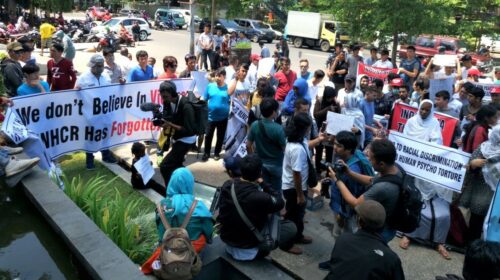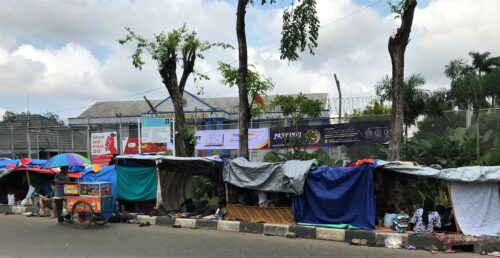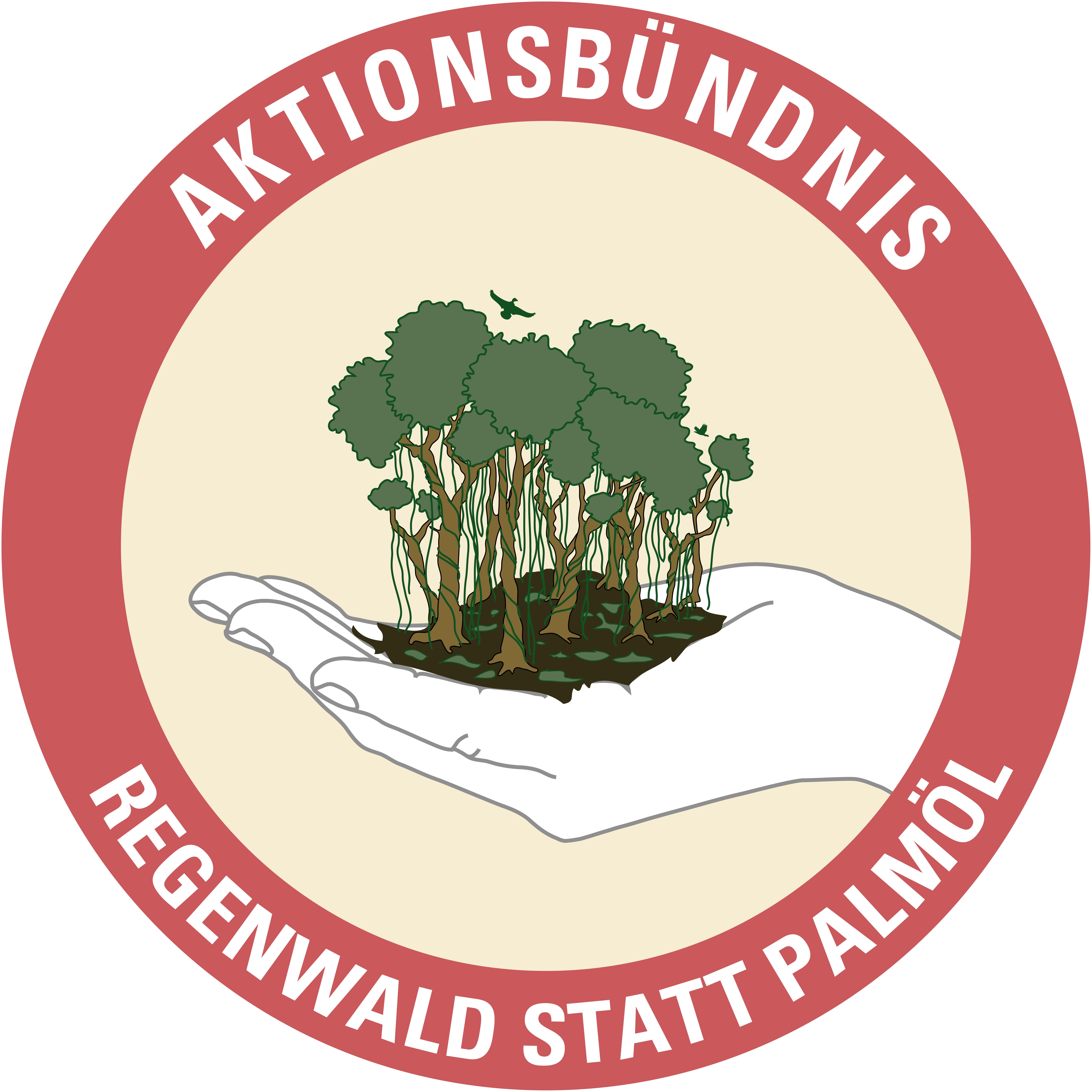
Refugees in Indonesia: Lingering in Permanent Limbo?
by Annika Püfke and Antje Missbach
Refugees protest in front of the UNHCR/IOM offices in Makassar (2019).
In December 2021, for the fourth time within the last two years, Indonesian authorities saw themselves forced to facilitate a rescue mission to save 105 Rohingya refugees, mostly women and children, from deadly danger at sea. Having fled persecution in Myanmar and then become stuck in refugee camps in Bangladesh, the Rohingya had suffered perilous conditions for more than a month, trapped on an unseaworthy boat and insufficiently equipped with water, food, and fuel. Indonesian officials, initially denying them entry into the country and preparing a pushback into Malaysian waters, had to give in to public pressure by NGOs and local fishermen when the vessel was at risk of capsizing just off the coast of Aceh. Once the boat had been towed to Lhokseumawe and the passengers had received medical attention, they were accommodated in a temporary camp (UNHCR 2021; Llwellyn 2021). Not even two months later, before the authorities were able to relocate them to Medan, more than half of them had fled this camp due to the unpromising prospects of refugee life in Indonesia (Nasution 2022).
Rohingya are not the only people who seek temporary shelter in Indonesia. The country has been hosting considerable numbers of refugees since the 1990s. According to the United Nations High Commissioner for Refugees (UNHCR), there are 13175 refugees and asylum seekers living in Indonesia as of November 2021, of which the majority are from Afghanistan, followed by Somalia and Myanmar (UNHCR 2021). Asylum seekers keep coming, although Indonesia is a country with little formal refugee protection.
While having acceded to neither the 1951 Refugee Convention nor its 1967 Protocol, Indonesia constitutionally grants the right to seek asylum and has put forward the Presidential Regulation (PR) 125/2016 as a legal framework for the treatment of asylum seekers and refugees. Rather than Indonesian government bodies, it is UNHCR which oversees registering each asylum seeker and evaluating their refugee claims (Refugee Status Determination). For those who are granted refugee status, the UNHCR then pursues a durable solution, of which there are three: resettlement, repatriation, or local integration. The UNHCR also provides support for unaccompanied children and stipends for the most vulnerable. In addition, the International Organization for Migration (IOM) covers accommodation, medical assistance, education and cash allowances to partly cover living expenses, at least for some of the more than 13,000 people registered with the UNHCR. During the Covid-19 pandemic, UNHCR and IOM launched vaccination campaigns for refugees (UNHCR 2021).
Indonesia is commonly considered a transit country, which means that for most who reach the archipelago, it is merely meant to be a stop-over en route to a third country, such as Australia or Canada, where they hope to be able to settle down permanently. However, it is the resettlement countries themselves that decide how many refugees they want to accept; the UNHCR does not have the authority to instruct them to offer opportunities of resettlement (Mohammadi and Askary 2022).
Most registered refugees in Indonesia used to be taken in by the USA, Canada, and Australia, but in recent years, those numbers have dropped dramatically due to changes in immigration policies and, in case of Australia, the implementation of extremely harsh and legally questionable border protection measures. With as little as 403 successful resettlements in 2020 (UNHCR 2021), waiting time for refugees in Indonesia has gradually increased to five years, and in some cases even ten years or more. Because repatriation to their countries of origin is not a viable option – many returnees would be subjected to war or persecution, which is why they left in the first place – Indonesia has effectively turned from a stepping stone into a cul de sac.
Refugee makeshift tents in front of the Kalideres detention centre, Jakarta (2019).
Even though many refugees face the dilemma of being unable to move forward or back, the Indonesian government avoids responsibility by adhering to its official claim that Indonesia remains just a transit country. It does not allow for integration into the local community as a suitable long-term solution for refugees, as became apparent in the provisions of the Presidential Regulation No. 125/2016, which seek to exert control over Indonesia’s ‘temporary visitors’ by imposing severe restrictions on their personal freedoms. Refugees staying in Indonesia face problems getting a proper education, moving freely, or even opening a local bank account. They also cannot work legally, which forces those who are not financially supported by organisations such as UNHCR or IOM into illicit employment, thus making them more vulnerable to exploitation and even (re)detention (Mohammadi and Askary 2022). Therefore, many refugees in Indonesia eventually end up living a life in limbo: with the path to resettlement obstructed, they are stuck for years on end in a country that denies them the most basic rights, creating a situation that is hopeless and seemingly permanent.
Considering that their lives are characterised by persistent challenges, insecurities, and lack of perspective, it should not come as a surprise that mental health problems have become rampant amongst refugees in Indonesia. At least 13 suicides have been recorded within the last three years (Mohammadi and Askary 2022). But despite the strict ban on political activity, refugees are increasingly trying to raise awareness of their desperation. In early 2022, Afghan refugees took to the streets in Pekanbaru following the suicide of a member of their community on January 16 (Allen 2022). Others set up a camp in front of the UNHCR and IOM offices in Jakarta in November and December 2021, desperately calling for more immediate aid (Tamer 2021). The Indonesian government mostly remained unmoved by these actions.
Besides public protests like these, refugee activism can take many other forms, such as launching petitions and social media campaigns or turning towards advocacy journalism. Some even publicly engage in self-harm, orchestrating hunger strikes or sewing their lips to express the feeling of having their voices silenced. As of January 2022, several Afghan refugees have set themselves on fire (Allen 2022).
Over the last decade, more Indonesian NGOs have become engaged in working for refugees, providing humanitarian aid and lobbying on their behalf (e.g. SUAKA, Dompet Duafa). But this kind of activism is unlikely to challenge the overall structural deficits asylum seekers and refugees currently face in Indonesia. In order to leave behind the status quo, the Indonesian government would have to accept that Indonesia is no longer a transit country and that many refugees are here to stay, and that many more might arrive in the years to come.
References
Allen, Sydney (2022) Police violently break up Afghan refugee protest in Indonesia. GlobalVoices. 20 January. https://globalvoices.org/2022/01/20/police-violently-break-up-afghan-refugee-protest-in-indonesia/.
Llewellyn, Aisyah (2021) Rohingya refugees brought ashore after dramatic Indonesia rescue. Al Jazeera. 31 December. https://www.aljazeera.com/news/2021/12/31/rohingya-refugees-brought-ashore-in-indonesia-after-navy-rescue.
Mohammadi, Sitarah, and Sajjad Askary (2022) Refugees live in destitution in Indonesia: Years of limbo and suffering lead refugees to protests for many weeks now for resettlement. Reliefweb. 10 January. https://reliefweb.int/report/indonesia/refugees-live-destitution-indonesia-years-limbo-and-suffering-lead-refugees.
Nasution, Rahmad (2022) Rohingya refugees in Aceh get second COVID-19 jab. Antara News. 18 February. https://en.antaranews.com/news/216113/rohingya-refugees-in-aceh-get-second-covid-19-jab.
Tamer, Rayane (2021) Why ‘abandoned’ refugees in Indonesia are sewing their lips together and self-immolating. SBS. 9 December. https://www.sbs.com.au/eds/news/why-abandoned-refugees-in-indonesia-are-sewing-their-lips-together-and-self-immolating/3d61331d-159d-45f6-922a-7854f3d52a7e.
UNHCR (2021) Fact Sheet Indonesia. November 2021. https://www.unhcr.org/id/wp-content/uploads/sites/42/2022/01/Indonesia-FactSheet-November-2021_FINAL.pdf
The authors:
Annika Püfke is a student of social and political science at Bielefeld University.
Antje Missbach is Professor of Sociology at Bielefeld University and author of The Criminalisation of People Smuggling in Indonesia and Australia: Asylum Out of Reach (Routledge, 2022).









